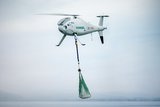New family of UAVs make appearance at UV Conference
A new family of Unmanned Airborne Systems is making its appearance at the UV Europe Conference being held at the Celtic Manor Hotel on 22 and 23 July 2009.
AESIR, named after a family of Norse gods, has developed a family of Vertical Take Off and Landing (VTOL) Unmanned Airborne Vehicles (UAVs) designed to operate in both urban and rural environments providing a platform suitable for tasks including surveillance and cargo lift.
The VTOL craft utilise the Coanda effect to generate lift and have inherent stability as a surveillance platform. The design has no external rotating parts and can survive low speed impact with the ground, buildings and other fixed objects.
“The AESIR craft offer considerable benefits over similar sized UAVs, not only is the space under the canopy fully useable but the design means that we are able to lift a much larger payload,” said Chris Newland, CEO of Aesir Ltd. “Though we have designed a range of products we also have the capability to customise these to meet a range of options depending on requirements,” he added.
The AESIR UAVs provide a sustained hover capability, have a large payload capacity when compared to similar sized fixed wing craft and have been designed to use “plug-and-play” payloads resulting in considerable flexibility. Designed into the craft is an effective perch-and-stare capability.
The AESIR family of craft range from a 300mm diameter craft called Vidar, through Odin which is a 1m diameter craft with a payload capability of 10kg, to Hoder which is a multi engine craft with the capability to lift a payload of 1 tonne.
Vidar is a man portable craft designed to provide surveillance and situational awareness inside buildings and in close confined spaces. It has an electric engine powered by Lithium Polymer batteries and a 15 minute endurance with a 100g payload.
Odin is fitted with a rotary internal combustion engine and can carry a 10kg payload for up to an hour. Fitted with an autonomous flight control system and managed through a simple to operate ground control system, it can be adapted to a range of tasks including ISTAR, communications relay, electronic warfare, asset protection, IED detection and can be used as a loitering munition.
Hoder is a heavy lift craft capable of carrying a one tonne payload. It is primarily intended for cargo transport but can easily be adapted to become a long endurance craft by reducing the payload and increasing the fuel. Hoder is in the early stages of development but is expected that it will be multi-engined.
More from Uncrewed Vehicles
-
Jammer resistant drone designs spark search for countermeasures
The Russia-Ukraine conflict has driven another stage of evolution for drones and the counter measures to defend against them.
-
![L3Harris launches Amorphous software for control of uncrewed platforms]()
L3Harris launches Amorphous software for control of uncrewed platforms
The new Amorphous software is a universal controller that would allow a single operator to control a swarm of “thousands” of uncrewed systems, from drones to underwater platforms.
-
ideaForge unveils new UAVs at Aero India 2025
India UAV supplier ideaForge has launched the Netra 5 and Switch V2 drones at Aero India 2025, boasting of enhanced endurance, AI-driven autonomy and improved operational capabilities.
-
![Shaping the future of defence: What 2025 holds for the global drone market]()
Shaping the future of defence: What 2025 holds for the global drone market
The UAV market is experiencing unprecedented growth, with innovations in technology and battlefield applications driving demand across military sectors. From the battlefields of Ukraine to NATO exercises and beyond, drones are transforming how wars are fought and supported.
-
![Maris-Tech confirms customers signing up for Jupiter Drones codec and AI-powered system]()
Maris-Tech confirms customers signing up for Jupiter Drones codec and AI-powered system
Launched at AUSA in October, the company’s multi-stream video codec is attempting to bring a new lease of life to drone technology through its AI accelerator.
-
![AUSA 2024: Quantum-Systems targets big 2025 with UAS developments]()
AUSA 2024: Quantum-Systems targets big 2025 with UAS developments
Quantum-Systems has been upgrading its UAS family, with new versions of the Vector, Reliant and Twister drones set for release throughout 2025.
























